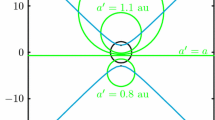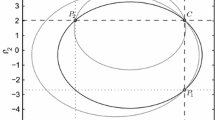Abstract
A method for the nonlinear propagation of uncertainties in Celestial Mechanics based on differential algebra is presented. The arbitrary order Taylor expansion of the flow of ordinary differential equations with respect to the initial condition delivered by differential algebra is exploited to implement an accurate and computationally efficient Monte Carlo algorithm, in which thousands of pointwise integrations are substituted by polynomial evaluations. The algorithm is applied to study the close encounter of asteroid Apophis with our planet in 2029. To this aim, we first compute the high order Taylor expansion of Apophis’ close encounter distance from the Earth by means of map inversion and composition; then we run the proposed Monte Carlo algorithm to perform the statistical analysis.
Similar content being viewed by others
References
Battin R.H.: An Introduction to the Mathematics and Methods of Astrodynamics. AIAA Education Series, New York (1968)
Berges, J., Rousseau, S., Perot E.: A Numerical Predictor-Corrector Guidance Algorithm for the Mars Sample Return Aerocapture. AAAF, 14–66, March (2001)
Bernelli-Zazzera, F., Berz, M., Lavagna, M., Makino, K., Armellin, R., Di Lizia, P., Jagasia, R., Topputo, F.: NEO Encounter 2029: Orbital Prediction via Differential Algebra and Taylor Models. Final Report, Ariadna id: 08-4303, Contract No. 20271/06/NL/HI (2009)
Berz, M.: The new method of TPSA algebra for the description of beam dynamics to high orders. Technical Report AT-6:ATN-86-16, Los Alamos National Laboratory (1986)
Berz, M.: The method of power series tracking for the mathematical description of beam dynamics. Nuclear Instrum. Meth. A258, 431 (1987)
Berz, M.: High-order computation and normal form analysis of repetitive systems. Phys. Particle Accel. AIP 249, 456 (1991)
Berz M., Joh K., Nolen J.A., Sherrill B.M., Zeller A.F.: Reconstructive correction of aberration in nuclear particle spectrographs. Phys. Rev. C 47, 537–544 (1993)
Berz M.: Differential Algebraic Techniques. Entry in Handbook of Accelerator Physics and Engineering. World Scientific, New York (1999a)
Berz M.: Modern Map Methods in Particle Beam Physics. Academic Press, London (1999b)
Berz M., Makino K.: COSY INFINITY version 9 reference manual. MSU Report MSUHEP-060803, Michigan State University, East Lansing, MI 48824, pp. 1–84 (2006)
Chesley S.R., Milani A.: An automatic earth-asteroid collision monitoring system. Bull. Am. Astron. Soc. 32, 682 (2000)
Chodas, P.W., Yeomans, D.K.: Predicting close approaches and estimating impact probabilities for near-Earth projects. AAS/AIAA Astrodynamics Specialists Conference, Girdwood, Alaska (1999)
Crassidis J.L., Junkins J.L.: Optimal Estimation of Dynamics Systems, pp. 243–410. CRC Press LLC, Boca Raton, FL (2004)
Di Lizia P., Armellin R., Lavagna M.: Application of high order expansions of two-point boundary value problems to astrodynamics. Celest. Mech. Dyn. Astron. 102, 355–375 (2008)
Erdelyi, B., Bandura, L., Nolen, J., Manikonda, S.: Code development for next-generation high-intensity large acceptance fragment separators. In: Proceedings of PAC07, Albuquerque, New Mexico, USA (2007)
Giorgini J.D., Benner L.A.M., Ostro S.J., Nolan M.C., Busch M.W.: Predicting the earth encounters of (99942) apophis. Icarus 193, 1–19 (2008)
Griffith, T.D., Turner, J.D., Vadali, S.R., Junkins, J.L.: Higher order sensitivities for solving nonlinear two-point boundary-value problems. In: AIAA/AAS Astrodynamics Specialist Conference and Exhibit, Providence, Rhode Island, August 16–19 (2004)
Hoefkens J., Berz M., Makino K.: Controlling the wrapping effect in the solution of ODEs for asteroids. Reliable Comput. 8, 21–41 (2003)
Junkins J., Akella M., Alfriend K.: Non-Gaussian error propagation in orbit mechanics. J. Astronaut. Sci. 44, 541–563 (1996)
Junkins J., Singla P.: How nonlinear is it? A tutorial on nonlinearity of orbit and attitude dynamics. J. Astronaut. Sci. 52, 7–60 (2004)
Maybeck P.S.: Stochastic Models, Estimation, and Control, pp. 159–271. Academic Press, New York (1982)
Milani A., Chesley S.R., Valsecchi G.B.: Asteroid close encounters with Earth: Risk assessment. Planet. Space Sci. 48, 945–954 (2000)
Milani, A., Chesley, S.R., Chodas, P.W., Valsecchi, G.B.: Asteroid close approaches: analysis and potential impact detection. Asteroids III, pp. 89–101 (2002)
Montenbruck O., Gill E.: Satellite Orbits, pp. 257–291. 2nd edn. Springer, New York (2001)
Park R., Scheeres D.: Nonlinear mapping of Gaussian statistics: theory and applications to spacecraft trajectory design. J. Guidance Control Dyn. 29, 1367–1375 (2006)
Park R.S., Scheeres D.J.: Nonlinear semi-analytic methods for trajectory estimation. J. Guidance Control Dyn. 30, 1668–1676 (2007)
Seidelmann P.K.: Explanatory Supplement to the Astronomical Almanac. University Science Books, Mill Valley, California (1992)
Vokrouhlický D., Chesley S.R., Milani A.: On the observability of radiation forces acting on near-earth a steroids. Celest. Mech. Dyn. Astron. 81, 149–165 (2001)
Author information
Authors and Affiliations
Corresponding author
Rights and permissions
About this article
Cite this article
Armellin, R., Di Lizia, P., Bernelli-Zazzera, F. et al. Asteroid close encounters characterization using differential algebra: the case of Apophis. Celest Mech Dyn Astr 107, 451–470 (2010). https://doi.org/10.1007/s10569-010-9283-5
Received:
Revised:
Accepted:
Published:
Issue Date:
DOI: https://doi.org/10.1007/s10569-010-9283-5




